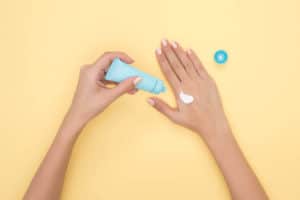Glycolic acid and retinol are two of the industry’s go-to ingredients for promoting young-looking, flawless, and even-toned skin. Do you need to keep them separate? Can you use glycolic acid and retinol together?
Glycolic acid and retinol are safe to use together for those with normal or oily skin. For those with sensitive or dry skin, it is best to use them separately.
Start with a 10-percent (or lower) glycolic acid solution. If your skin has no irritation, then you can try using it together with retinol.
There are many precautions and tips to consider. Read on to learn more about whether you can use glycolic acid and retinol together and the benefits of each!
Also, for an excellent facial moisture cream, take a look at our top pick, the INNOAESTHETICS AGE RESCUE 24H CREAM :
Click here to see it on Amazon.
Can You Use Glycolic Acid and Retinol Together?
Both glycolic acid and retinol have great potential to help your skin. However, they can make your skin dry, irritated, and extra sensitive to sunlight, especially if used improperly.
I have learned this from my own experience with clients that glycolic acid and retinol used together are fine for those with normal or oily skin. Those with dry or sensitive skin may have trouble if they use them together.
To confirm, I asked Dr. Lily Talakoub, a Virginia-based dermatologist, who said, “It can be effective to use glycolic acid and retinol together. Just ensure you are moisturizing well to keep your skin hydrated.”
She said after washing in the evening, you can apply your moisturizer, then apply the glycolic acid and retinol, and then finish with another thin layer of moisturizer.
She did caution anyone with dry or sensitive skin to avoid using glycolic acid and retinol together as it can be too harsh on their skin.
Glycolic Acid
Glycolic acid is the most common type of AHA (alpha hydroxy acid), a skin exfoliant. An exfoliant removes the outer layer of the skin to bring out brighter, lighter, and fresher skin.
The great thing about glycolic acid is it’ is made of very fine particles compared to other AHAs. This means it can penetrate deeper into your hair follicles and skin to remove dead skin, sebum, and excess oil, which could’ve otherwise clogged your pores.
When your pores are clogged, it could result in blackheads, whiteheads, and acne or pimple breakouts.
Glycolic acid isn’t just great for unclogging your pores or preventing breakouts. You can also use it to fade scars or dark spots, even your skin tone, and lessen the effects of aging, such as dryness and wrinkles, by increasing collagen production.
Retinol
Retinol is part of the retinoid family, which is a catch-all term for vitamin-A derivatives. It’s a strong retinoid, but it’s usually tolerable, especially by people with oily skin. For people with sensitive or dry skin, it might cause irritation.
For the first few weeks of using topical retinol, as it accelerates skin cell turnover, you could experience dryness, flaking, itching, peeling, redness, and general inflammation.
This surface appearance of the skin is one of the reasons people get scared of using this retinoid in their skin care routine. However, dermatologists believe that everyone could benefit from this retinoid.
As a skin care ingredient, retinol shares some of the benefits of glycolic acid. They both renew and regenerate the skin and boost collagen production to get rid of age spots, fine lines, wrinkles, mild acne scarring, dry skin, and post-inflammatory hyperpigmentation.
What’s more, it stimulates new blood vessels in the skin, so you can have that rosy complexion and natural glow.
Glycolic acid and retinol have plenty of skin-boosting benefits. Whether you’re planning to use them together or alone, it’s important to know how to use them properly to get the results you want to achieve without damaging your skin in the process.
That’s what we’ll discuss in the next sections of this article.
See the below video for some great insights and tips on can you use glycolic acid and retinol together?
What You Shouldn’t Mix with Glycolic Acid and Retinol
Retinol is an unpredictable chemical and doesn’t go along well with many ‘actives’ (chemicals that hydrate, rejuvenate, and nourish the skin at a cellular level).
Mixing it and glycolic acid with the wrong skincare products or chemicals could make them useless, weak, or worse, cause severe skin reactions.
Here are some ingredients you should avoid mixing with glycolic acid:
- Salicylic acid – Unless your skin is too oily, you should avoid using salicylic acid, glycolic acid, and retinol at the same time because it could cause excessive skin dryness.
- Vitamin C – Mixing vitamin C with alpha-hydroxy acids, such as glycolic acid, could make it less effective.
- Niacinamide (vitamin B3) – This vitamin requires an environment with a neutral pH. When mixed with AHAs, which has a low pH, they form niacin. This could lead to mild skin irritation and flushing.
Here are some ingredients you should avoid mixing with retinol:
- Vitamin C – Combining the two won’t work because each of them is formulated at different pH/acidity levels. However, not everyone shares the same opinion. They say vitamin C helps retinol work better by preventing oxidization, which makes it less potent.
- Benzoyl peroxide – Using both at the same time could cause further skin irritation. Dermatologists recommend using retinol at nighttime and benzoyl peroxide in the daytime.
- Hyaluronic acid – If you use retinol, which can cause dryness, you’ll cancel out the hydrating effects of hyaluronic acid. But with the right formulation, the two could still work together to replenish moisture back into your skin and ease irritation.
When and How to Use Glycolic Acid and Retinol
You might be asking yourself right now, “How can I safely and effectively use glycolic acid or retinol in my skin care routine?”
So, let’s start with glycolic acid.
If it’s your first time using this skin acid, use a lower concentration before increasing the strength. A 10-percent (or lower) glycolic acid solution is a good start.
Allow time for your skin to adjust to it. If your skin is extra sensitive, or if you don’t know how your skin will react to it, try skin care products with glycolic acid (or retinol) with hydrating ingredients.
Listen to your skin. If it becomes a little irritated or red after application, find the frequency of use that works best for you.
A minimum of 10-percent glycolic acid could be used daily or more than once per week. If you have oily skin, you can use 30-percent glycolic acid twice per week.
See the INNOAESTHETICS AGE RESCUE 24H CREAM , which has a mild 10% glycolic acid solution. It is perfect for starting out with glycolic acid and if you don’t want to irritate your skin.
Click here to see it on Amazon.
For more oily skin, you can try the goop Beauty 15% Glycolic Acid Overnight Peel :
Click here to see it on Amazon.
Other things you need to remember when using glycolic acid for your skin:
- Buy a product containing around 5 to 8 percent of glycolic acid if it’s your first time to use it. You can increase the concentration or application frequency after around 21 to 28 days. By then, your skin has already adjusted to the acid and could probably handle a higher concentration.
- Do a small skin patch test. Apply a small amount of the glycolic acid solution on your inner forearm and wait for 30 minutes to 24 hours for reactions.
- Never leave it on your skin overnight. Check the label to know how long you should leave the product on your skin. A good rule of thumb is to leave glycolic acid for not more than 2 or 3 minutes.
- Don’t use glycolic acid if you: frequently tan in the sun or a tanning bed, recently used or are still using acne meds, have thinned or sensitized skin, and have undergone a dermabrasion or microdermabrasion procedure.
- Don’t forget to moisturize after applying a skin care product with glycolic acid in it.
Now, let’s talk about retinol.
Retinol is most effective when applied at night. Start by using it two to three times every week. Don’t use too much. A pea-sized amount is more than enough. If your skin becomes too dry, you can try lowering the concentration and using it once per week or every other night.
It may take longer for over-the-counter retinol to work. Prescription retinol doesn’t share the same problem, but it’s usually more difficult to tolerate.
Other things you need to remember when using retinol for your skin:
- Important: Read labels and instructions before use. Retinol can do serious damage if you don’t use it properly. Some of its possible side effects are irritation, minor burns, dermatitis (or skin inflammation), and erythema (redness due to increased blood flow).
- Wear sunscreen. Retinol does make your skin more sensitive to sunlight. That’s why it’s important to use sunscreen (with moisturizer, if possible) to avoid damaging your skin.
- Take a break. Use retinol for not more than 3 to 4 months. Pay attention to your skin’s reaction, and then re-introduce retinol back in your skincare routine to get the best possible results.
- Apply a moisturizer. Like glycolic acid, retinol can be drying and irritating. Wash your face, and then apply a gentle moisturizer. Then, put a small amount of retinol before applying another layer of gentle moisturizer. This is a good routine to follow for people who have sensitive skin.
- Like glycolic acid, don’t forget to do a skin patch test prior to full use.
See the StriVectin-AR Advanced Retinol Concentrated Serum for an advanced retinol formula that evens out skin tone and leaves a more radiant complexion.
Click here to see it on Amazon.
Conclusion – Can You Use Glycolic Acid and Retinol Together?
So, can you use glycolic acid and retinol together? You can use glycolic acid (or other alpha hydroxy acids) and retinol together if you have oily or normal skin. If you have dry or sensitive skin, it is best to only use glycolic acid at first (10% strength or less).
Then if there is no irritation on the dry or sensitive skin, then you can mix or use it together with retinol.
There are so many conflicting opinions about using the two together. Everyone’s skin can react differently, so the most important is to just start with a small patch skin test to see if there is irritation or not.
Related reading:
Can You Use Glycolic Acid and Vitamin C Together?
Can You Use Glycolic Acid and Salicylic Acid Together?
Which Is Better: Retinol or Glycolic Acid?







